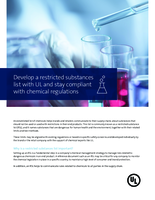
Develop your RSL for your consumer products with UL
Understand RoHS compliance challenges and learn how to mitigate potential risks.

Human health is directly tied to environmental health in many ways. From the air we breathe to the water we drink and the ground we rely on to grow our food, humans need a healthy environment.
At the intersection of human health and environmental concerns is a focus on hazardous substances, including heavy metals, flame retardants and phthalates. These substances can have negative impacts on health and the environment during the various stages of a product’s lifecycle, from production to disposal.
As human and environmental protection becomes more important to consumers and businesses alike, many governments have introduced environmental protection legislation to help regulate the use of these substances across numerous product categories, including electrical and electronic equipment (EEE).
In Europe, the European Union (EU) Restriction of Hazardous Substances Directive (RoHS) is the most widespread regulation dedicated to hazardous substances in EEE.
Compliance with EU RoHS is part of the CE marking process and is required for all EEE manufacturers seeking to sell or distribute products within the EU. Other regulations exist in countries around the world.
RoHS and other regulations represent an essential focus on health and they also create challenges for manufacturers and their supply chain partners.
Earning and maintaining compliance under EU RoHS requires dedicated resources, diligence and a robust understanding of the requirements in each market.
The original EU RoHS, Directive 2002/95/EC, was first published by the European Union in 2002. This Directive restricted the use of six hazardous materials found in electrical and electronic products: lead, cadmium, mercury, hexavalent chromium, polybrominated biphenyls (PBB) and polybrominated diphenyl ethers (PBDE).
Products containing any of the listed substances could not be placed on the European market if they exceeded specified thresholds (up to 0.1% for each substance except cadmium, which was restricted to 0.01%).
However, EU RoHS was created specifically to be an evolving requirement to ensure it could respond appropriately to the newly released products and latest science related to potential hazards. In 2011, Directive 2011/65/EU introduced RoHS 2 and replaced Directive 2002/95/EC.
Most notably, RoHS 2:
On December 7, 2023, the European Commission (EC) officially published a report on the review of the RoHS Directive.
Based on this report, the RoHS Directive will not undergo a full revision at this point. Instead, it will be subject to a specific amendment concerning the reallocation of scientific and technical responsibilities to the European Chemicals Agency (ECHA).
Despite the points mentioned earlier, there is potential to enhance the RoHS Directive. This is particularly relevant because hazardous substances in electrical and electronic equipment (EEE) continue to be a significant concern within the context of the circular economy.
The goal to evaluate and potentially limit specific hazardous substances remains substantial, especially in cases where new substances used in EEE conflict with the Directive’s objectives.
Considering the interaction with other legislative measures currently under review (i.e., REACH Regulation), RoHS Directive could potentially face a future revision.
Along with restrictions, EU RoHS also includes a list of exemptions (Annex III and IV of the Directive) for applications lacking a suitable replacement for the substance in question. For example, mercury in fluorescent lamps or cadmium and its compounds in electrical contacts for some EEE categories.
These exemptions are constantly reviewed to keep pace with new products, evolving technologies and discoveries or developments that could potentially lead to replacements. Manufacturers may also request an exemption by submitting details regarding the necessity of the hazardous substance.
RoHS requires EEE manufacturers to prepare declarations of conformity and affix the CE marking on finished products to conduct a conformity assessment and demonstrate compliance.
Manufacturers must develop technical documentation and carry out an internal production control procedure (Module A, Annex II, Decision 768/2008/EC) to demonstrate RoHS compliance.
It is also mandatory to build a technical file showing the method for verifying a product’s compliance. The European Commission developed a harmonized standard on the required technical documentation for the presumption of conformity: EN IEC 63000:2018.
Manufacturers may demonstrate compliance through supplier and material declarations, contractual agreements, analytical test results or a combination of these methods. Although there is no prescriptive method, IEC 63000, IEC 62321-2 Annex B and IEC TR 62476 can be used as guidance to build a sound RoHS conformity assessment and risk assessment.
Typically, a thorough assessment involves three steps:
In all cases, a sound EU RoHS assessment is a complex process that should begin in the earliest design phases and continue through to end-of-use and disposal.
The EU RoHS regulation was the first regulation of its kind in Europe, but similar legislations exist in many other countries, including the United Kingdom, South Korea, China, the United Arab Emirates, Saudi Arabia and Japan. However, these regulations are not identical. For example, the Saudi Standards, Metrology and Quality Organization (SASO) RoHS shares the same original substances and limits as EU RoHS but does not include phthalates.
There are also additional regulations manufacturers must consider when preparing their products for the global market. These regulations and directives share the same larger objectives — the protection of human health and the environment — but their specific focuses differ. For example:
Regardless of where a product may be sold, it has never been more critical for retailers and manufacturers to understand what their products are made of and how these substances and components can affect compliance, circularity, sustainability, and human and environmental health.
Manufacturers selling their products in multiple markets must consider a variety of regulations that cover everything from safety and performance to chemical compliance. Even if you’re only pursuing a single market, managing the different requirements across various standards requires dedicated expertise and resources.
UL Solutions helps companies address RoHS compliance challenges and manage potential risks. Whether you need to test your products and materials, analyze materials within products to determine compliance or pursue a combination of both approaches, we can support you with our comprehensive services, including:
Evolving regulations, varying regional requirements, and an increasing focus on human health and environmental impact highlight the importance of having a reliable testing, inspection, and certification provider. By easing the process every step of the way, UL Solutions can become an invaluable partner and help you remain competitive and increase market access in today’s global market.
Learn more about our chemical management services for EEE products.

Develop your RSL for your consumer products with UL
UL Solutions takes a holistic chemical compliance approach to electrical and electronic products to help you enhance safety across your supply chain and meet sustainability initiatives.
Thanks for your interest in our products and services. Let's collect some information so we can connect you with the right person.